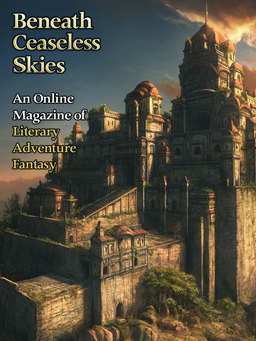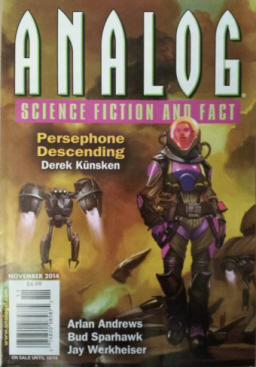Selling Short Fantasy, Science Fiction and Horror Fiction, Part I
 A little while ago, I blogged about The Economics of Short Fiction and feedback was that there’s interest in a short series (no pun intended) on the selling of short fiction, which is a fascinatingly complex topic.
A little while ago, I blogged about The Economics of Short Fiction and feedback was that there’s interest in a short series (no pun intended) on the selling of short fiction, which is a fascinatingly complex topic.
To be clear, this won’t be about the craft of writing. I’ve got lots of thoughts on creativity and the craft, some of which came out in an interview I gave to the excellent podcast the Creative Writer’s Tool Box.
In this first post on selling short fiction, I want to tackle three important pieces: (1) finding markets, (2) knowing the markets, and (3) knowing yourself.
So let’s assume you’re reading this post because you’ve written a short story, of say 5,000 words, and you’ve never looked at markets before. That’s where I was about eleven years ago.
Finding markets
There are a few places that compile market information on publishers of short fiction. I know some people swear by others for their multifunctionality [like www.duotrope.com or The (Submission) Grinder], but I find www.ralan.com far easier to use because independent of filters, there’s a list I can just browse. I’ve donated money to Ralan because I find this site so useful.
At Ralan, under the banner, you’ll see links to click on Pro markets, Semi-Pro markets, Pay markets, and Token markets (which I believe was once called 4-the-luv markets, which seemed more evocative to me). Pro markets pay SFWA rates, which are 6 cents a word and more. Semi-pro markets pay 3-5 cents a word, pay markets pay 1-2 cents, and token markets are anything below that. Ralan also shows you the lengths they publish and any sub-genres (ex.: sf/f/h means they take science fiction, fantasy and horror).
I’ll throw in a big caveat about the pay divisions in markets: In general, the better stories will be found in the higher-paying markets, but not always. I think Lackington’s is a high-quality, growing market; Ideomancer puts out some beautiful stuff; and GigoNotoSaurus specializes in pieces of fiction of uncommon lengths (bigger than a short story and shorter than a novel). All that to say, don’t rate your markets purely on pay, although pay is important.
Knowing markets
 So, it’s great to have this list of markets and pay rates and lengths, but that doesn’t really tell you if your story is right for a particular editor. Editors have editorial tastes. Some think about it a lot (ex.: Analog Science Fiction and Fact, Beneath Ceaseless Skies, and Lackington’s Magazine have strongly-worded editorial visions). Many other magazines seem to spring up from nowhere with a lot less clarity of vision. But without knowing the markets, you’re shooting in the dark.
So, it’s great to have this list of markets and pay rates and lengths, but that doesn’t really tell you if your story is right for a particular editor. Editors have editorial tastes. Some think about it a lot (ex.: Analog Science Fiction and Fact, Beneath Ceaseless Skies, and Lackington’s Magazine have strongly-worded editorial visions). Many other magazines seem to spring up from nowhere with a lot less clarity of vision. But without knowing the markets, you’re shooting in the dark.
The only way you’re really going to know a market is to read several issues. I personally hate this advice. Partly because it is long and not as rewarding as it sounds, because while you can find a lot you do like, there’s also a lot you won’t like. That’s normal. I also hate this advice because it’s true.
So in 2003, when I was starting out in short fiction, I subscribed to Asimov’s, Analog, F&SF, and Fantasy Magazine and read them. After a couple years, I switched subscriptions to On Spec and then discovered the audio publishers (Escapepod, PodCastle). That led me to the audio versions of Beneath Ceaseless Skies, Lightspeed and Clarkesworld.
Now is really a great period if you’re a relatively broke writer trying to research markets. So many magazines are offering their fiction online, as e-books, or in audio, so that even for free, you can read quite widely. This isn’t to say you shouldn’t pay for these. Many have voluntary donation buttons, and this is how many keep afloat.
My rule of thumb was that I would keep count of how many I listened to, and then donated to each magazine at the end of the year to the tune of 50 cents per story (which is pretty close to what you pay for Asimov’s or Analog). If you’re really broke or cheap, and you still want to give something to the magazine, you can do a lot of good by writing a little review on whatever website is appropriate (Goodreads, Amazon, iTunes, a bigger review blog like this one, or promotion of stories you like through social media).
Out of all this reading, somewhere, you will tend to find things you like and in others, you will tend to find things you don’t like. Keep track of that.
Knowing yourself
Until now, this post has presumed that you understand where your story fits into the short fiction ecosystem. Everyone have a good laugh about that. I’ll wait.
OK, so despite being very systematic by nature, I didn’t understand my place in the ecosystem until I started selling more consistently. The reason is this: Rejections can mean a lot of things from “this isn’t good enough” to “this is good, but not right for my market” to “this is great and great for my market, but I just bought three stories just like it.”
I’m assuming that most of my rejections have been in the “this isn’t good enough” category, if only because it prompts me to get better with the next story, even as I’m pushing this one onto the next market.
Only acceptances give you data you can really use, because they only mean one thing: “yes, this is good enough and it’s right for my market.”
As an example, one of my most illuminating experiences on knowing my writing was at the Asimov’s party at ChiCon, just after Stan Schmidt had retired from his long editorship at Analog. The new editor, Trevor, had previously worked as managing editor on a couple of my Asimov’s stories and now he was at Analog. I told him I had a number of Asimov’s sales, but a mittful of Analog rejections, and I was wondering if, now in his new job, he’d be able to articulate why stories of mine that had sold to Asimov’s didn’t work for Stan.
The answer took some months for both of us to get to, but basically boiled down to my writing, while being hard sf, not being exactly what his readers were wanting or expecting. He knew what his audience wanted, and I had to understand how my writing differed from what his audience expected. I then set out to write a story with Analog in mind. This later sold to Analog as “Persephone Descending.” I couldn’t have done it without understanding what I wrote first so I could know how to alter it appropriately for a different market. The other key message in this is that there was nothing wrong with my writing. It was editorial vision and how, initially, I didn’t know how to match it.
In two weeks, I’ll blog about sales, contracts, payments, and what rights you’re selling when you sell short fiction.
Derek Künsken sells his short science fiction and fantasy from Gatineau, Québec. You can find out more about him at www.derekkunsken.com or @derekkunsken.
If you’re interested in reading more about selling short fiction, Writers Digest will have some resources, and Toronto-area writer Doug Smith has written Playing the Short Game: How to Market & Sell Short Fiction. I’ll be mentioning more of Doug in my third post on Reprints and Foreign Rights.

The late, great George Scithers over at Weird Tales is the only editor I ever had the pleasure of corresponding with who would send back detailed notes on why a story didn’t work or why he would/could not publish it. I don’t know if he treated every submission in such a fashion, but I know he always did mine.
I also like to check Ralan. Even if it is just to find new magazines to consider looking at. Very good points regarding writing for your market. One also has to consider some magazines financial structure, which I suppose one can only discover by communicating with editors.
Per example, I once submitted a story to Aurealis (Australia). Over and above the stories rejection based on it not being good enough, the editor mentioned they were – at the time – quite reliant of a government grant to keep afloat. This translated to them publishing predominantly local authors, with only a few exceptions being made for superior quality work from offshore.
Derek, I can see why “Persephone Descending” is a closer fit to ANALOG than, say, “Schools of Clay”, even though both are very hard SF. (And both are rather political, and from a labor perspective too.)
I still suspect that “Persephone Descending” might have been a harder sell to Stan Schmidt than to Trevor Quacchri … though who knows?
I have to say that I think it’s a bit of a shame that the premier Hard SF magazine is not the place you go for really far out hard SF ideas, like those in “Schools of Clay” or “Way of the Needle”. I can kind of decode why that is, but I still think it’s a shame.
Ty: Good point. I know that Beneath Ceaseless Skies always writes a little something in their rejections. Better than no feedback at all.
Tiberius: That’s another good point. On Spec, for example, has historically had minimum thresholds of Canadian content to qualify for grants; probably Aurealis is in the same boat.
Rich: I’m working with only one data point now with Analog for myself, but I notice that since Trevor took over, Ken Liu, Lavie Tidhar and some others seem to be appearing in it whom I don’t think I remember seeing before.
dk
[…] everybody. Welcome to the second of a three-post series on selling short fiction. Last time I talked about knowing the markets and how your own writing fits into them. This week I want to […]
[…] is the third of three posts about selling short fiction. We’ve talked about how to know how to fit your story into the ecosystem of short fiction markets and what the business side (contracts, rights, etc) look like. This one is about […]